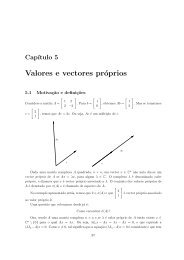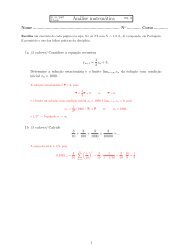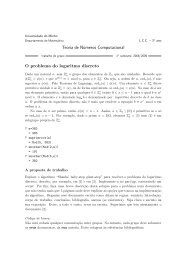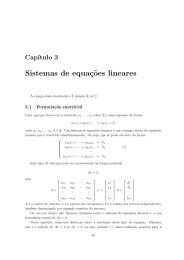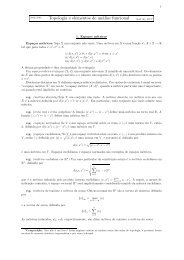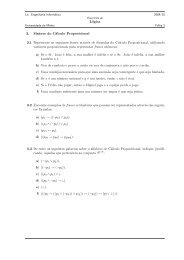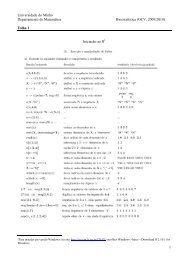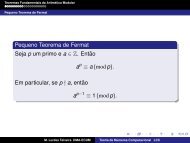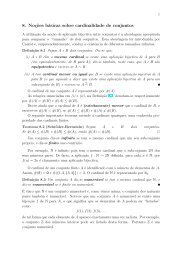My title - Departamento de Matemática da Universidade do Minho
My title - Departamento de Matemática da Universidade do Minho
My title - Departamento de Matemática da Universidade do Minho
You also want an ePaper? Increase the reach of your titles
YUMPU automatically turns print PDFs into web optimized ePapers that Google loves.
6 FLOWS 43<br />
Counter-example.<br />
Both the curves x(t) = 0 and x(t) = t 3 solve the equation<br />
ẋ = 3x 2/3<br />
with initial condition x(0) = 0. The problem here is that the velocity field v(x) = 3x 2/3 , although<br />
continuous, is not differentiable and not even Lipschitz at the origin. You may notice that the<br />
solution starting, for example, at x 0 = 1 reaches (or better comes from) the singular point x − = 0<br />
in finite time, since<br />
∫ 0<br />
t(x − ) − t(x 0 ) =<br />
1<br />
1 3 y−2/3 dy<br />
= −1 .<br />
One-dimensional Newtonian motion in a time in<strong>de</strong>pen<strong>de</strong>nt force field. The onedimensional<br />
motion of a particle of mass m subject to a force F (x) that <strong>do</strong>es not <strong>de</strong>pend on time<br />
is <strong>de</strong>scribed by the Newton equation<br />
mẍ = −U ′ (x) ,<br />
where the potential U(x) = − ∫ F (x)dx is some primitive of the force. The total energy<br />
E (x, ẋ) = 1 2 mẋ2 + U(x)<br />
(which of course is <strong>de</strong>fined up to an arbitrary additive constant) of the system is a constant of<br />
the motion, i.e. is constant along solutions of the Newton equation. In particular, once a value E<br />
of the energy is given (<strong>de</strong>pending on the initial conditions), the motion takes place in the region<br />
where U(x) ≤ E, since the kinetic energy 1 2 mẋ2 is non-negative. Conservation of energy allows to<br />
reduce the problem to the first or<strong>de</strong>r ODE<br />
ẋ 2 = 2 (E − U(x)) ,<br />
m<br />
which has the unpleasant feature to be quadratic in the velocity ẋ. Meanwhile, if we are interested<br />
in a one-way trajectory going from some x 0 to x, say with x > x 0 , we may solve for ẋ and find the<br />
first or<strong>de</strong>r autonomous ODE<br />
√<br />
2<br />
ẋ = (E − U(x)) .<br />
m<br />
There follows that the time nee<strong>de</strong>d to go from x 0 to x is<br />
t(x) =<br />
∫ x<br />
x 0<br />
dy<br />
√<br />
.<br />
2<br />
m (E − U(y))<br />
The inverse function of the above t(x)<br />
√<br />
will give the trajectory x(t) with initial position x(0) = x 0<br />
2<br />
and initial positive velocity ẋ(0) =<br />
m (E − U(x 0)), at least for sufficiently small times t.<br />
6.3 Exponential<br />
The exponential. The exponential function, according to Walter Rudin “the most important<br />
function in mathematics” ([Ru87], 1st line of page 1), is the unique solution of the (autonomous)<br />
differential equation<br />
ẋ = x<br />
with initial condition x(0) = 1. Actually, it is convenient to complexify time, i.e. take z = t+iθ ∈ C<br />
with t, θ ∈ R, and <strong>de</strong>fine the exponential as the power series<br />
exp(z) = 1 + x + x2<br />
2 + x3<br />
6 + x4<br />
24 + · · · = ∑ z n<br />
n!<br />
n≥0<br />
Since lim sup n→∞ (1/n!) 1/n = 0, the radius of convergence is ∞, hence the power series <strong>de</strong>fines an<br />
entire function, i.e. a holomorphic function exp : C → C. Deriving each term of the series, we





